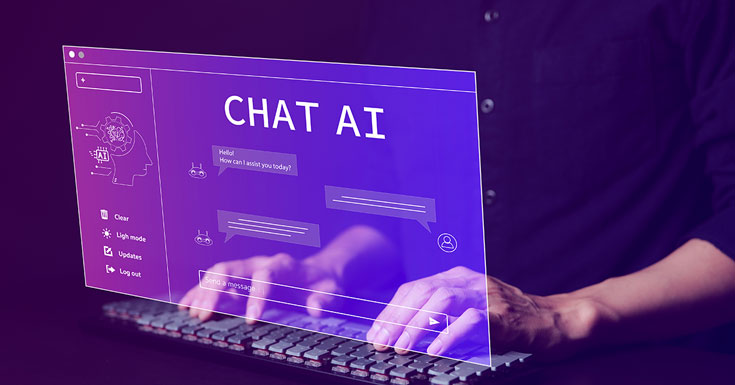The Evolution of the Chatbot: Introducing Generative AI
Senior Analyst

To meet expectations around timely, relevant, and personalized communications amid budget cuts, staffing shortages, and other pressures, many higher education institutions are turning to chatbots—more recently, generative artificial intelligence (AI) chatbots.
Institutions have been using chatbots for years now. However, recent solution advancements that utilize generative AI have profound implications for higher education, which has been selecting chatbot solutions at considerably higher rates than before the pandemic.
Meeting Instant Communication and Service Demands
Gen Z, the primary target audience for many institutions, is known for preferring quick, informal, text-based communication. They also expect the convenience and constant access to information and support they get from their favorite brands in every interaction─and this extends to their future or current institution.
With the introduction of generative AI chatbots, institutions may soon be able to better meet student and alumni demand for information and support when they need it, regardless of when an office is open, or staff are available.
From Basic to Generative AI Chatbots
Early chatbots leveraged basic keyword recognition to return predefined or scripted responses. These were helpful in answering simple questions or fielding users to the appropriate human contact but were fairly limited in functionality, quality, and accuracy.
As chatbots evolved, they became more conversational, could process and understand more words to answer more complex questions, and could even perform some internal tasks like setting reminders. Many of these chatbots scraped departmental or college website data to populate responses. As the limits of the chatbot were reached, the solutions featured a seamless handover to an appropriate staff member.
Now many chatbots entering the market use large language models (LLMs), which allow them to better understand context and sentiment and provide more tailored, accurate, and human-like interactions. Several provide functionality through Open AI’s ChatGPT.
New solutions are also moving away from web scraping and are tying into enterprise solutions including CRMs, core student systems, and advancement solutions for data. This can provide the ability to go beyond simply answering questions to taking action on behalf of an authenticated student. It also offers the potential to save staff significant time, allowing advisors and counselors to work with students who have more complex needs.
Generative AI Chatbot Use Cases in Higher Education
Below are a few examples of how higher education institutions might use generative AI chatbots across the student lifecycle to better connect with and serve their community:
- Fielding prospective student requests—Using SMS, bots can create customized prospect communication utilizing Natural Language Understanding (NLU) to analyze context, semantics, and user intent.
- Responding to transcript and other requests—Through integration with student systems, bots can execute transcript requests or other similar requests using the system of record to have the transcript shipped to the current address on file.
- Contributing to student success—Through student system integration, bots can regularly evaluate student progress and flag at-risk students earlier. Many solutions feature virtual advisor functionality with a seamless handoff to an actual advisor when needed.
- Engaging alumni and donors—Bots can help alumni remain engaged with the campus community by notifying them about events, opportunities to connect with fellow alumni in their area, and fundraising opportunities related to programs or activities they care about.
- Optimizing staff time—Bots can create email responses to students using functionality powered by generative AI, allowing staff to devote more time to students with more complex issues.
The Top 6 Standalone AI Chatbots by Market Share
Below are the top six AI chatbots in higher education by market share, listed alphabetically. To see each solution’s specific market share, including a breakdown by institution type and size, along with an overview of each chatbot solution and which use generative AI, clients can access our full 2023 Field Guide: Selecting AI Chatbots.
- Ivy.ai Ivy
- Mainstay Oli
- Mainstay Web Chat
- Modern Campus Signal Vine
- Mongoose Research Cadence
- Ocelot AI Chatbot
Only a few available solutions feature generative AI integrations, while others rely solely on Natural Language Processing and other functionality. I predict that solutions not utilizing generative AI will likely see their market share decrease precipitously.
Considerations for Purchasing a Generative AI Chatbot
Take an Enterprise-Wide Approach
Oftentimes chatbots are purchased with a specific use case in mind—recruitment, financial aid, and advancement, for example—but with this new leap in technology, institutions need to start taking an enterprise-wide approach. This will ensure that they can get the most use out of their investment and that any selection is anchored on a robust data governance program for optimal success.
Determine the Data Source and Data Governance
While ChatGPT integration can provide a significantly more sophisticated solution, it is not without risk as it is a public tool. The algorithm and training data may potentially generate bias or ethical concerns with its generated responses, which could damage an institution’s reputation. The need for a robust data management program is more essential than ever when incorporating this type of technology. Institutions can start by determining what data sources will feed the chatbot and ensure the data has been cleaned appropriately to mitigate bias.
Develop the User Experience
Institutions will want to determine the user experience for both staff and faculty as well as students and alumni. For example, when will handoffs to a staff member occur? The evolution of generative AI capabilities will continue to make this less clear as chatbots are able to generate more sophisticated responses emulating human interaction, but some topics will always be best handled in one-on-one conversations with a person rather than via text with a bot.
Categories
Share Article:

Other Posts From this Author:
© Copyright 2025, The Tambellini Group. All Rights Reserved.